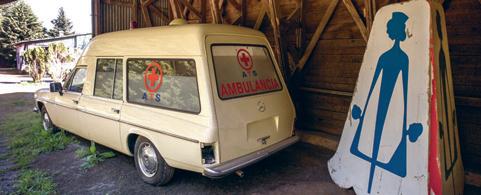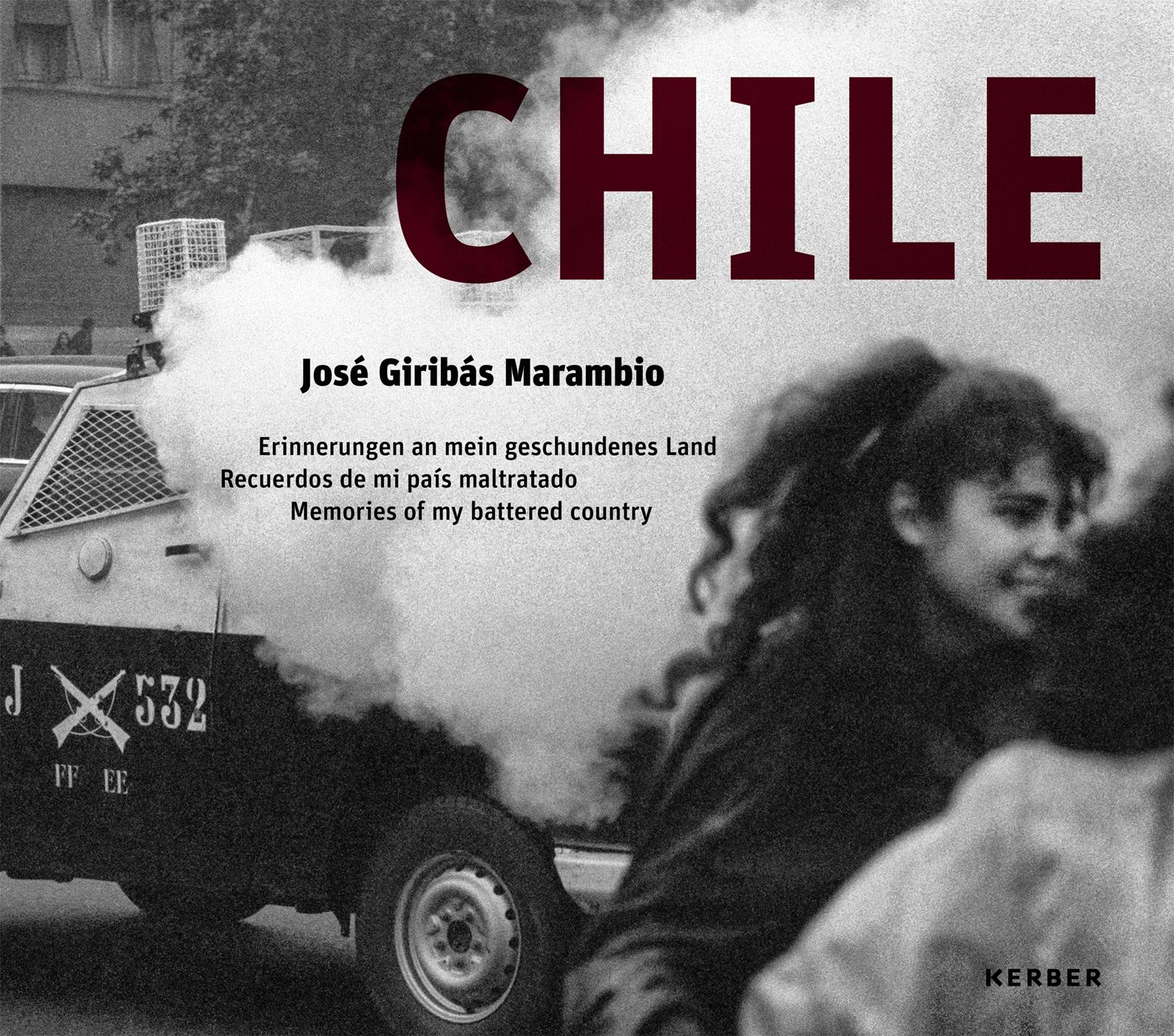
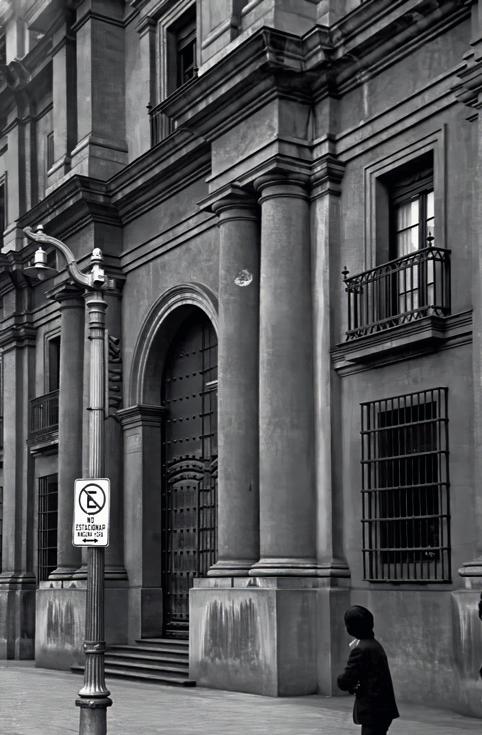
Spuren eines Schusses in einer Säule des Präsidentenpalastes „La Moneda“ nach dem vereitelten Militärputsch „Tanquetazo“.
Huellas de un disparo en una columna del palacio presidencial “La Moneda” tras el golpe militar frustrado “Tanquetazo”.
Traces of a shot in a column of the presidential palace “La Moneda” after the thwarted military coup “Tanquetazo.”
Santiago, 29-06-1973
Die ersten Fotos in diesem Buch wurden am 29. Juni 1973 während eines versuchten Militärputsches, bekannt als „Tanquetazo“, aufgenommen. Dieser wurde von den Streitkräften, die der demokratisch gewählten Regierung von Präsident Allende noch treu waren, verhindert.
An diesem Morgen unternahm ich meine ersten Schritte als Fotograf, indem ich mit meiner gebrauchten Yashica Lynx 5000, die ich in Raten von einem Karmeliterpater gekauft hatte, loszog, um Fotos zu machen.
Am Abend dokumentierte ich die von Allende einberufene Demonstration, die vor dem Präsidentenpalast „La Moneda“ stattfand, mit meiner in der UdSSR hergestellten Panoramakamera. Diese Kamera bekam ich mit viel Glück und Entschlossenheit dank eines Telefonats mit der Botschaft der Sowjetunion. Natürlich habe ich die Kamera auch in Raten bezahlt. In meiner Anfangszeit als Fotograf war das meine gesamte Fotoausrüstung.
Die übrigen Fotos in diesem Buch stammen aus den Jahren ab 1986. In jenem Jahr kehrte ich nach zwölf Jahren Exil für eine Weile als Pressefotograf nach Chile zurück, um den Alltag unter dem diktatorischen Regime von General Pinochet für die deutsche Presse zu dokumentieren – mit meinen damaligen Kameras: Leica M3 und Nikon F2.
Las primeras fotos de este libro fueron tomadas el 29 de junio del 1973 durante un intento de golpe de estado militar que se conoció como “Tanquetazo”, Este fue impedido por las fuerzas militares leales al gobierno democráticamente elegido del presidente Allende.
Por la mañana de ese día comencé a dar mis primeros pasos como fotógrafo documental, saliendo a reportear con mi cámara de segunda mano Yashica Lynx 5000 comprada a plazos a un sacerdote carmelita.
Al atardecer documenté la manifestación convocada por Allende, que tenía lugar frente al palacio presidencial “La Moneda” con mi Cámara panorámica fabricada en la URSS. Conseguí esta cámara con mucha suerte y determinación gracias a una llamada telefónica a la Embajada de la Unión Soviética. Por supuesto, la cámara también la pagué a plazo. En mis comienzos como fotógrafo, ese era todo mi equipo.
El resto de las fotografías de este libro datan de 1986 en adelante. En ese año, tras doce años de exilio, regresé a Chile por un tiempo como fotógrafo de prensa para documentar la vida cotidiana bajo el régimen dictatorial del general Pinochet para la prensa alemana con mis cámaras de entonces: Leica M3 y Nikon F2.
The first photos in this book were taken on June 29, 1973, during an attempted military coup known as the “Tanquetazo.” This coup was thwarted by the armed forces, who were still loyal to the democratically elected government of President Allende.
On the morning of that day, I began my photographic career by going outside to take pictures with my second-hand Yashica Lynx 5000 camera, which I had bought in installments from a Carmelite priest.
In the evening, I documented the demonstration called by Allende in front of the presidential palace “La Moneda” with my Panoramic camera manufactured in the USSR. I got this camera through luck and determination after a phone call with the Soviet Union embassy. Of course, I also paid for this camera in installments. At the beginning of my photographic career, these cameras made up my entire photographic equipment.
The other photos in this book date from 1986 onward. In 1986, after twelve years in exile, I returned to Chile as a press photographer. There I documented everyday life under the dictatorial regime of General Pinochet for the German press with my cameras at the time, the Leica M3 and Nikon F2.
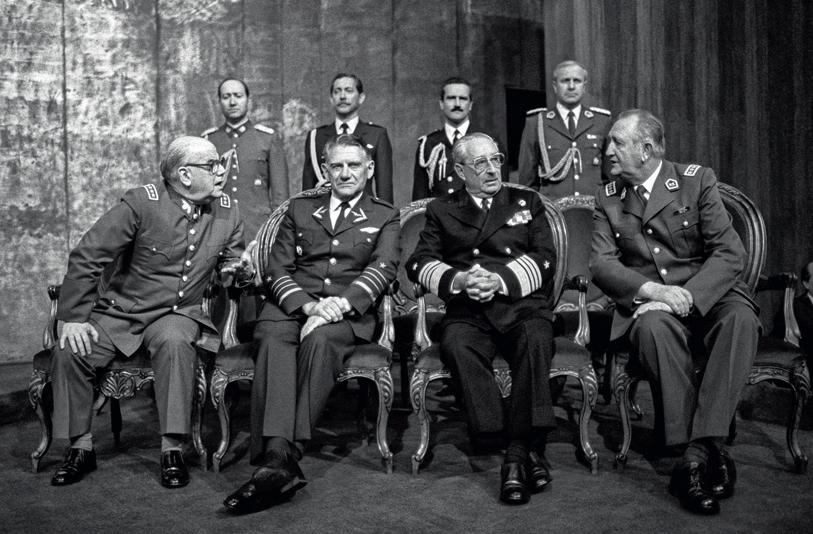
Die Militärjunta im Gebäude Diego Portales. Von links nach rechts: Humberto Gordon Rubio, General des Heeres, Mitglied der Militärjunta von 1986 bis November 1988 und Chef des Geheimdienstes CNI von Juli 1980 bis Oktober 1986; Fernando Jorge Matthei Aubel, General der Luftwaffe, Mitglied der Militärjunta von 1978 bis November 1990; José Toribio Merino, Marineadmiral, Mitglied der Militärjunta von 1973 bis 1990 und Rodolfo Stange Oelckers, Oberkommandierender der Polizei (Carabineros), Mitglied der Militärjunta von 1985 bis 1990. La Junta Militar en el edificio Diego Portales. De izquierda a derecha: Humberto Gordon Rubio, General de Ejército, miembro de la Junta Militar de 1986 a noviembre de 1988 y jefe del servicio de inteligencia CNI de julio de 1980 a octubre de 1986; Fernando Jorge Matthei Aubel, General de la Fuerza Aérea, miembro de la Junta Militar de 1978 a 1990; José Toribio Merino, Almirante de la Armada, miembro de la Junta Militar de 1973 a 1990 y Rodolfo Stange Oelckers, comandante en jefe de Carabineros, miembro de la Junta Militar de 1985 a 1990.
The military junta in the Diego Portales building. From left to right: Humberto Gordon Rubio, General of the Army, member of the military junta from 1986 to November 1988 and Chief of Intelligence of the CNI from July 1980 to October 1986; Fernando Jorge Matthei Aubel, General of the Air Force, member of the military junta from 1978 to November 1990; José Toribio Merino, Navy Admiral, member of the military junta from 1973 to 1990; and Rodolfo Stange Oelckers, Commander-in-Chief of the Police (Carabineros), member of the military junta from 1985 to 1990.
Santiago, 30-08-1988
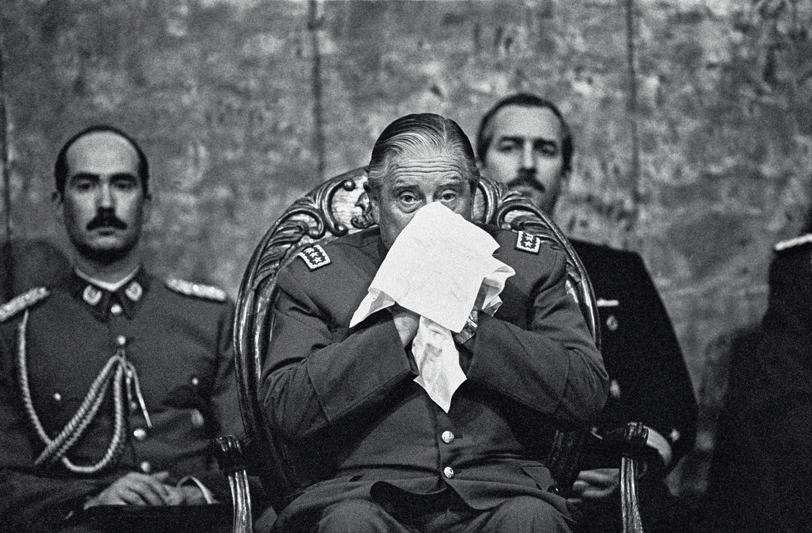
Heute ist die „Brigada Ramona Parra“ (BRP) zu einem der bemerkenswertesten künstlerischen Kollektive Lateinamerikas geworden.
Sie wurde 1968 von einer Gruppe junger chilenischer Kommunisten gegründet und erhielt ihren Namen nach Ramona Parra, einer 19-jährigen kommunistischen Arbeiterin, die 1946 bei einer als „la masacre de la Plaza Bulnes“ (Massaker am Bulnes-Platz) bekannten Demonstration in Santiago von der Polizei erschossen wurde.
Die Kulturbrigade „Ramona Parra“ malt ein Wandgemälde während einer Demonstration für das NEIN zu Pinochets Plebiszit. Text: „Gegen die Diktatur malen wir“.
La brigada cultural “Ramona Parra” pinta un mural durante una manifestación a favor del NO al plebiscito de Pinochet.
The cultural brigade “Ramona Parra” paints a mural during a demonstration for the NO to Pinochet’s plebiscite. Text: “We paint against the dictatorship.”
Santiago, 01-10-1988
En la actualidad, la “Brigada Ramona Parra” (BRP) se ha convertido en uno de los colectivos artísticos más notables de América Latina.
Fue fundada en 1968 por un grupo de jóvenes comunistas chilenos y debe su nombre a Ramona Parra, una obrera comunista de 19 años que murió por disparos de la policía en 1946 durante una manifestación en Santiago conocida como “la masacre de la Plaza Bulnes”.
Today, the “Brigada Ramona Parra” (BRP) is one of the most outstanding artistic collectives in Latin America.
It was founded in 1968 by a group of young Chilean communists. The name of the brigade is derived from Ramona Parra, a nineteen-year-old communist worker who was shot dead by the police in 1946 during a demonstration in Santiago, known as “la masacre de la Plaza Bulnes” (Bulnes Square Massacre).
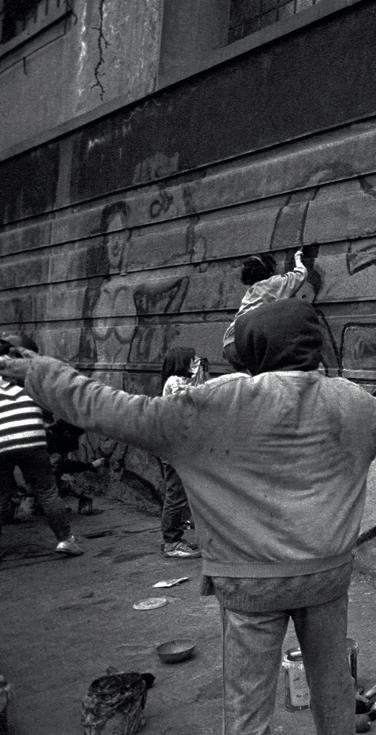
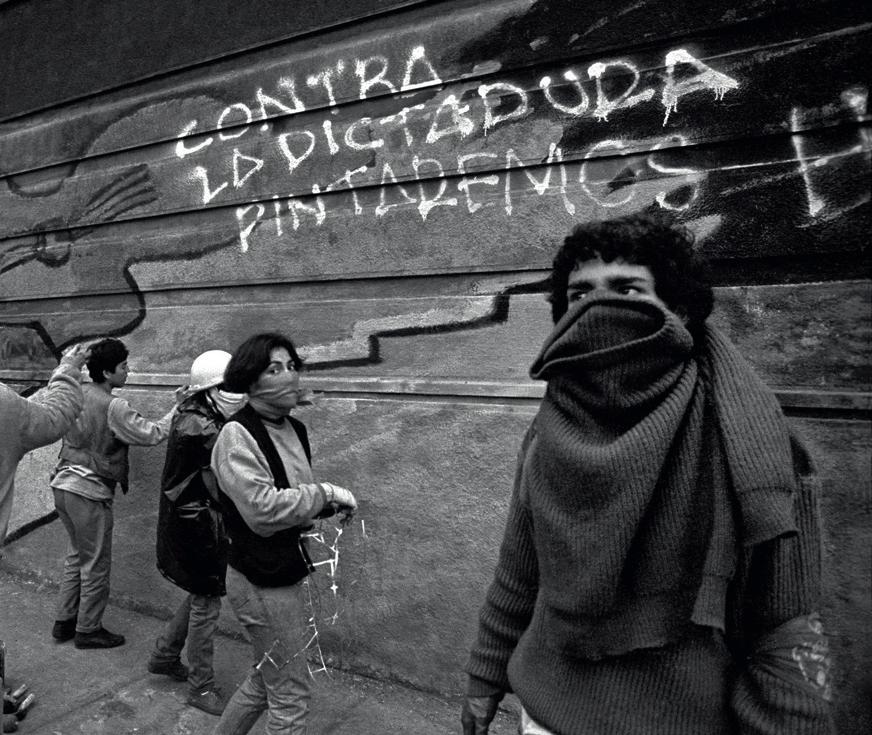
Frauen kleben Plakate für einen Marsch anlässlich des zweiten nationalen Tages für Wahrheit, Gerechtigkeit, Freiheit und gegen Straflosigkeit.
Mujeres pegando afiches para una marcha durante la segunda Jornada Nacional por la verdad, la justicia, la libertad y contra la impunidad.
Women put up posters for a march on the occasion of the second national day for truth, justice, freedom and against impunity.
Santiago, 06-09-1988
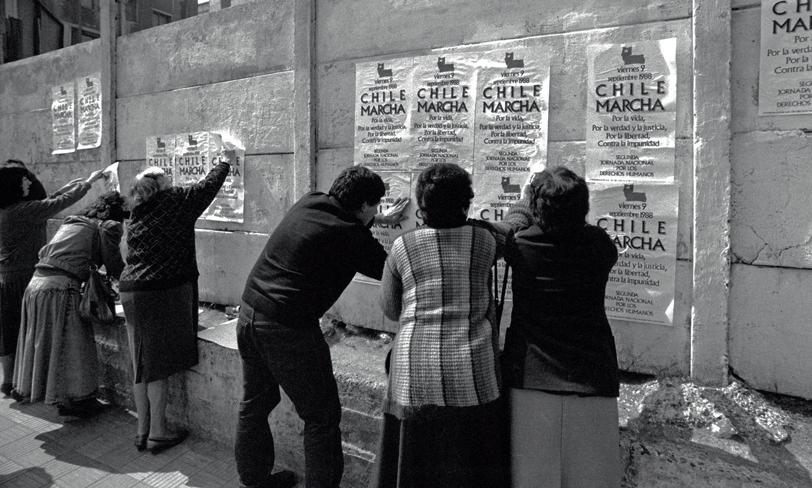
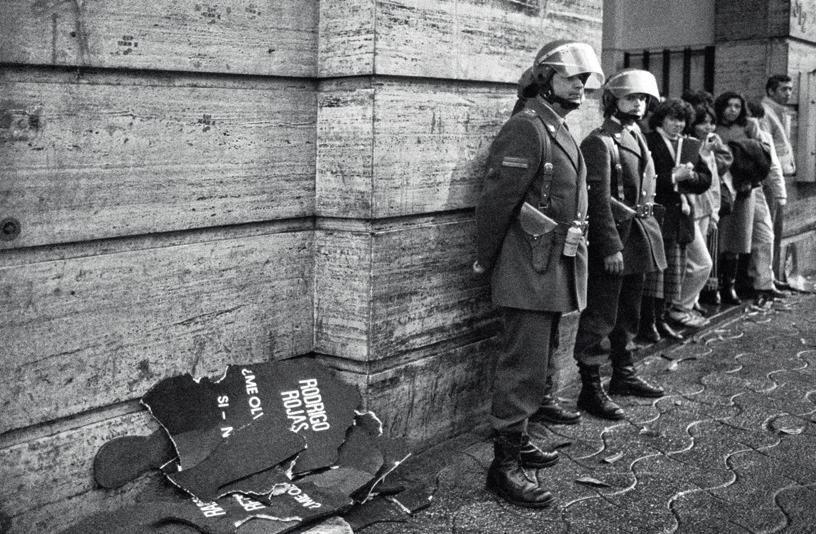
Während einer von der Gruppe „Mujeres por la vida“ (Frauen für das Leben) organisierten Demonstration stehen Polizeibeamte (Carabineros) neben Styroporfiguren, die von ihnen beschlagnahmt und zertrümmert wurden.
Durante una manifestación organizada por el grupo “Mujeres por la vida” agentes de policía (Carabineros) permanecen junto a figuras de poliestireno, confiscadas y destruidas por ellos.
During a demonstration organized by the group “Mujeres por la vida” (Women for Life), police officers (Carabineros) stand next to polystyrene figures that they have confiscated and smashed. Santiago, 08-09-1988
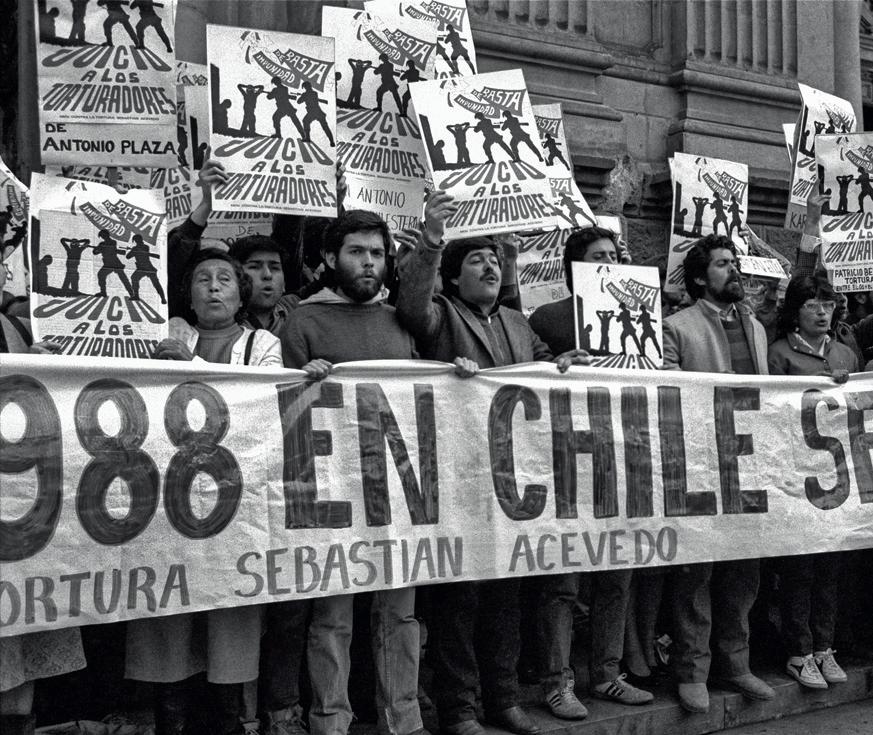
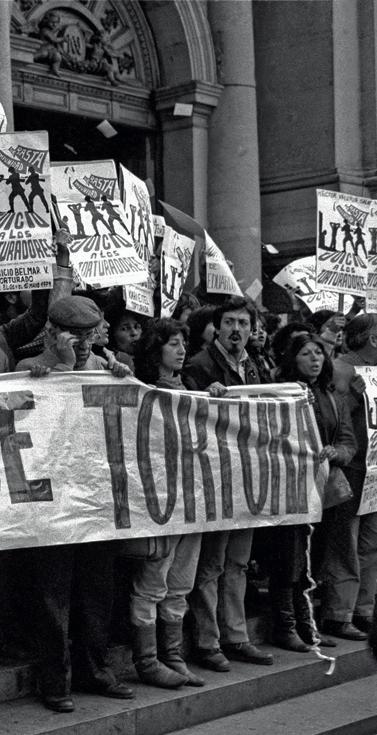
Mit seiner Selbstverbrennung vor der Kathedrale von Concepción am 11. November 1983 protestierte Sebastián Acevedo gegen die Entführung seiner Söhne durch nicht identifizierte bewaffnete Zivilisten.
Con su autoinmolación frente a la catedral de Concepción el 11 de noviembre 1983, Sebastián Acevedo protestó contra el secuestro de sus hijos por civiles armados no identificados.
With his self-immolation in front of the Concepción cathedral on November 11, 1983, Sebastián Acevedo protested against the abduction of his sons by unidentified armed civilians.
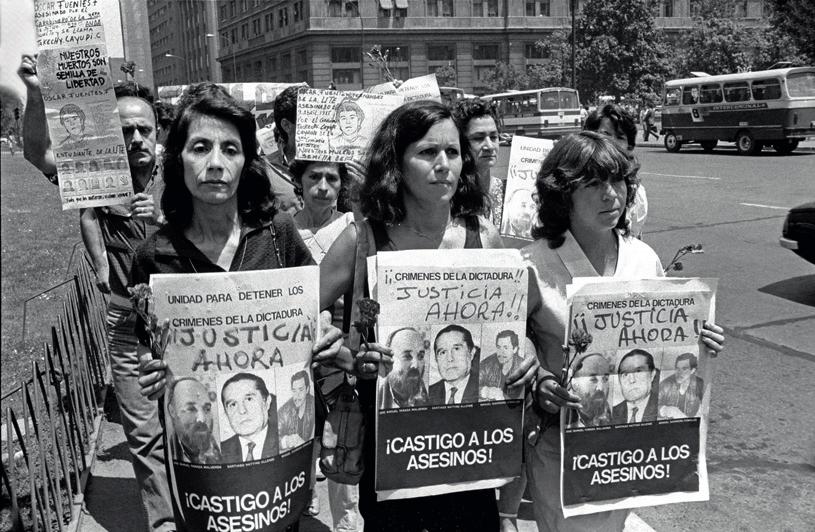
Die Witwen von José Manuel Parada Maluenda, Santiago Nattino Allende und Manuel Leonidas Guerrero Ceballos (sie wurden von Polizeibeamten entführt und am 30. März 1985 getötet) demonstrieren für Gerechtigkeit gegenüber des Präsidentenpalastes „La Moneda“.
Las viudas de José Manuel Parada Maluenda, Santiago Nattino Allende y Manuel Leonidas Guerrero Ceballos (ellos fueron secuestrados por Carabineros y asesinados el 30 de marzo 1985) se manifiestan pidiendo justicia frente al palacio presidencial “La Moneda”.
The widows of José Manuel Parada Maluenda, Santiago Nattino Allende, and Manuel Leonidas Guerrero Ceballos (they were kidnapped by police officers and killed on March 30, 1985) demonstrate for justice in front of the presidential palace “La Moneda.”
Demonstration für Menschenrechte, organisiert von der Gruppe „Frauen für das Leben“.
Manifestación por los derechos humanos, organizada por la agrupación “Mujeres por la vida”.
Demonstration for human rights, organized by the group “Women for Life.”
Santiago, 08-09-1988
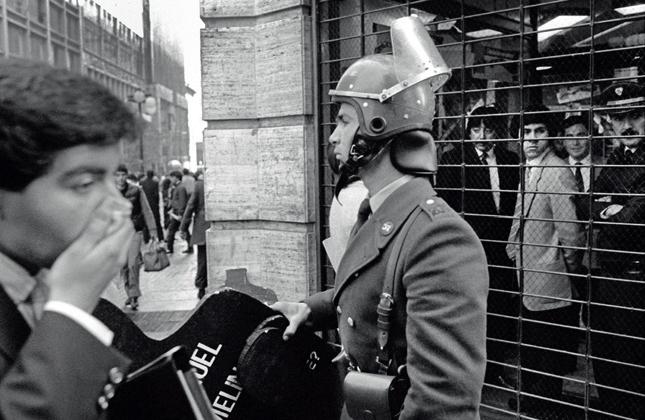
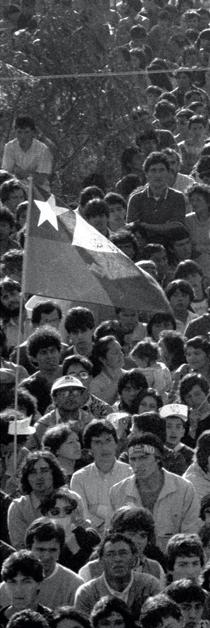
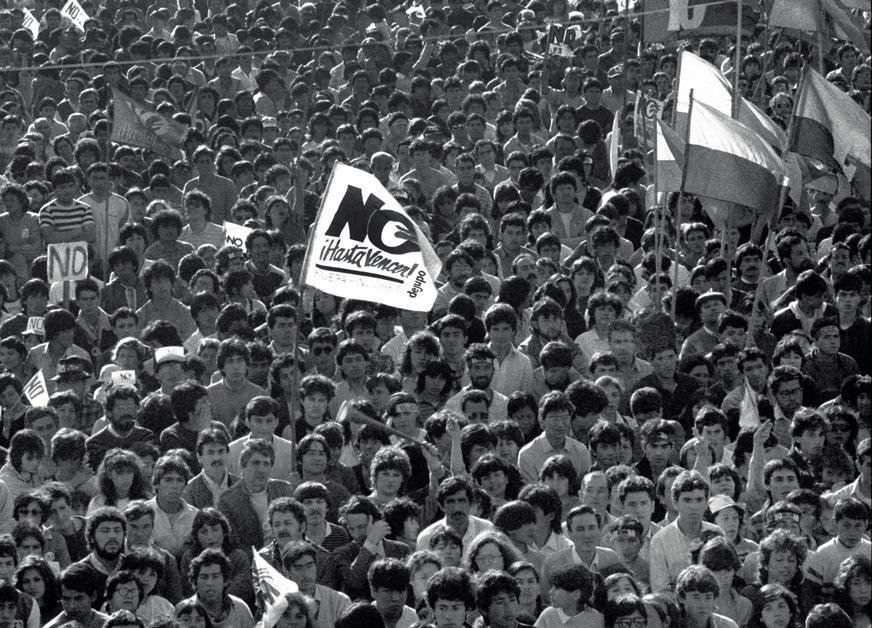
Die teilnehmerstärkste NEIN-Demonstration fand vier Tage vor dem Plebiszit in Santiago statt. La manifestación por el NO con más participantes tuvo lugar en Santiago cuatro días antes del plebiscito. The demonstration for the NO with the highest number of participants took place in Santiago four days before the plebiscite.
Santiago, 01-10-1988
Menschen, die einen Monat und fünf Tage vor der Plebiszit an einem Kiosk eifrig Schlagzeilen lesen.
Die populärste chilenische Zeitung jener Zeit, Fortín Diario (rechts), hatte den Mut, ein falsches und lächerliches Endergebnis zu veröffentlichen: „Pinochet 4 Stimmen“, verstanden als die Stimmen von den vier Mitgliedern seiner Militärjunta.
Gente leyendo ávidamente los titulares de los periódicos en un quiosco un mes y cinco días antes del plebiscito.
El periódico chileno más popular de la época, Fortín Diario (a la derecha), tuvo el valor de publicar un falso y ridículo resultado final: “Pinochet 4 votos”, se entiende que eran de los cuatro miembros de su junta militar.
People eagerly reading newspaper headlines at a kiosk one month and five days before the plebiscite.
The most popular Chilean newspaper of the time, Fortín Diario (right), had the courage to publish a false and ridiculous final result: “Pinochet four votes,” understood as the votes of the four members of his military junta.

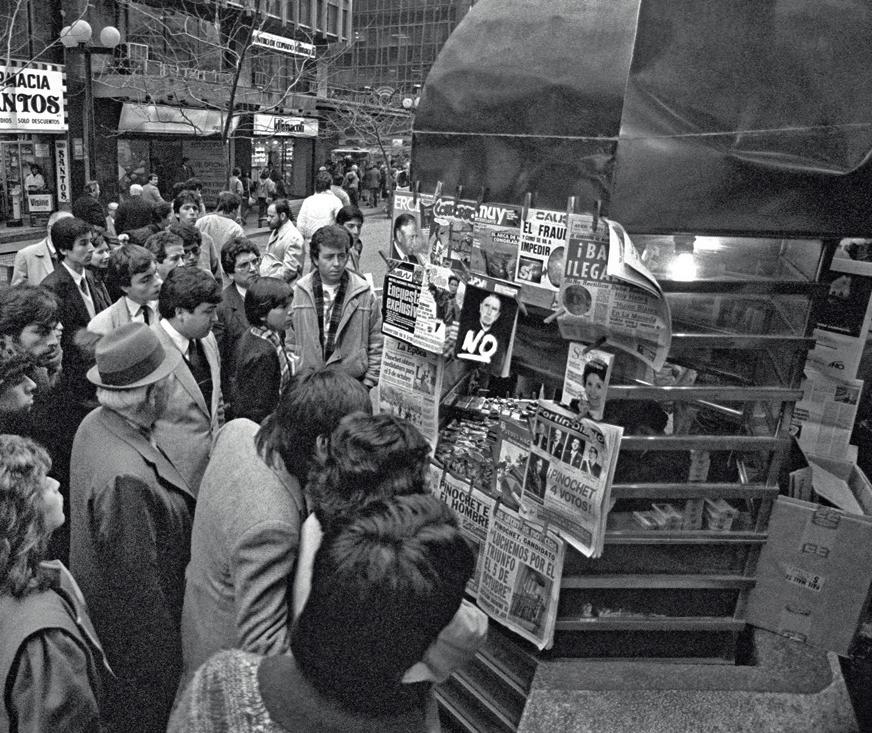
Der Weiße Saal „Präsident Allende“ im Präsidentenpalast „La Moneda“. El Salón Blanco “Presidente Allende” en el palacio presidencial “La Moneda”. The White Hall “President Allende” in the presidential palace “La Moneda.” Santiago, 12-07-2016
Das Weiße Saal „Präsident Allende“ ist das Zimmer, in dem Salvador Allende starb.
Hinter dem Originalschreibtisch von Salvador Allende befindet sich ein Bild von ihm, das von dem chilenischen Künstler Aldo Bahamonde gemalt wurde. Diese Gedenkstätte wurde am 11. September 2008 von Präsidentin Michelle Bachelet eingeweiht.
El Salón Blanco “Presidente Allende” es la habitación donde Salvador Allende falleció.
Detrás del escritorio original de Salvador Allende se puede ver un cuadro del presidente Salvador Allende Gossens del artista chileno Aldo Bahamonde. Este memorial fue inaugurado por la presidenta Michelle Bachelet el 11 de septiembre 2008.
The White Room “President Allende” is the room in which Salvador Allende died.
Behind the original desk of Salvador Allende is a picture of him, painted by the Chilean artist Aldo Bahamonde. This memorial was inaugurated by President Michelle Bachelet on September 11, 2008.

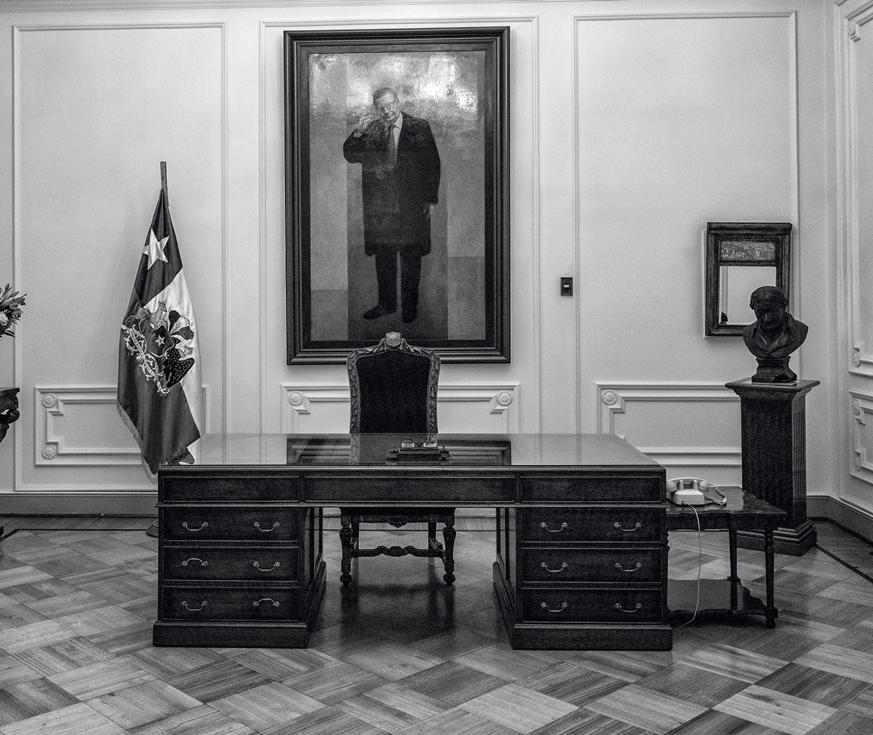
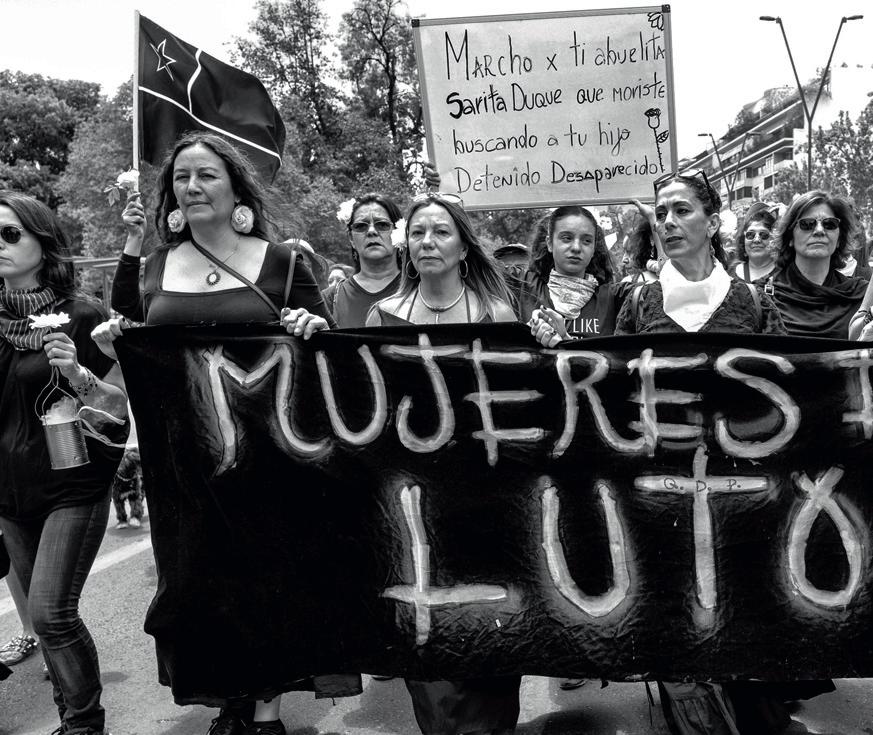
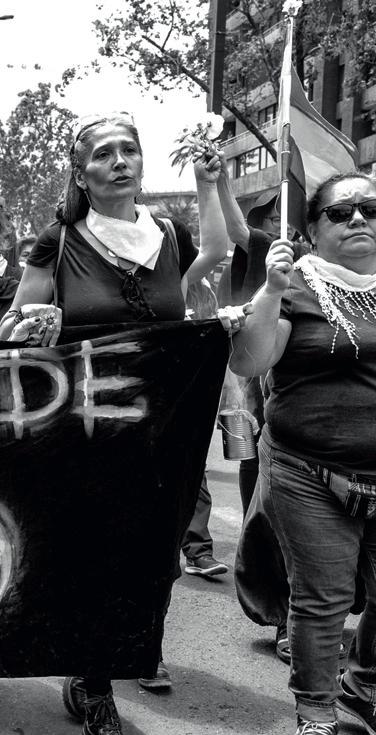
Sozialer Aufschrei
Am 18. Oktober 2019 begannen die Proteste gegen die Erhöhung des U-Bahn-Tarifs um 30 Cent. Dieser Protest entwickelte sich zu einem täglichen Kampf mit vielen Schäden und Verletzten. Mehr als 400 Menschen erlitten Augenverletzungen, weil die Polizei sie mit Schrotkugeln beschoss.
Die Lage im Land beruhigte sich erst im März 2020 mit dem Beginn der Coronavirus-Pandemie.
In Stille und in strenger Trauer eröffneten mehr als tausend Frauen einen neuen Tag der Demonstrationen in Santiago. Mit schwarzen Kleidern und weißen Schals würdigten sie die „Gefallenen“ in Anspielung auf die 23 Menschen, die inmitten der Proteste starben.
Estallido social
El 18 de octubre de 2019 comenzaron las protestas contra la subida de 30 céntimos en la tarifa del metro. Esta protesta se convirtió en una batalla diaria con muchos daños y heridos. Más de 400 personas sufrieron heridas en los ojos porque la policía les disparó perdigones.
La situación en el país no se calmó hasta marzo de 2020 con el inicio de la pandemia de coronavirus.
En silencio y luto severo, más de mil mujeres abrieron una nueva jornada de manifestaciones en Santiago. Con vestidos negros y pañuelos blancos, honraron a los “caídos” en referencia a las 23 personas que murieron en medio de las protestas.
Social Outcry
On October 18, 2019, the protests against the 30-cent subway fare increase began. This protest developed into a daily battle, resulting in a lot of damage and injuries. More than 400 people suffered eye injuries because the police fired shotgun pellets at them.
The situation in the country only calmed down in March 2020 with the start of the coronavirus pandemic.
In silence and stern mourning, more than a thousand women started a new day of demonstrations in Santiago. Wearing black dresses and white scarves, they paid tribute to the twenty-three people who had died in the midst of the protests.

während einer
am
Ein an einem Auge verletzter Demonstrant auf der Plaza Baquedano.
Participante herido en un ojo, en Plaza Baquedano.
Protester injured in one eye at Plaza Baquedano. Santiago, 24-10-2019
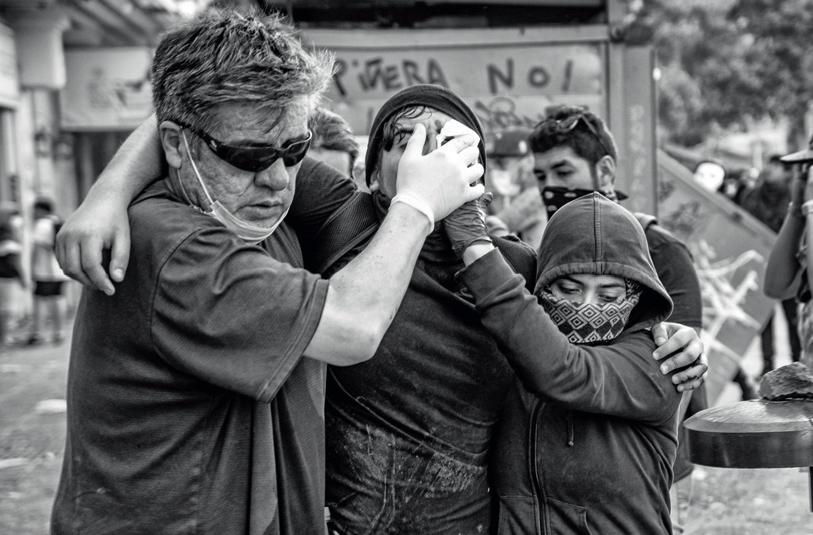
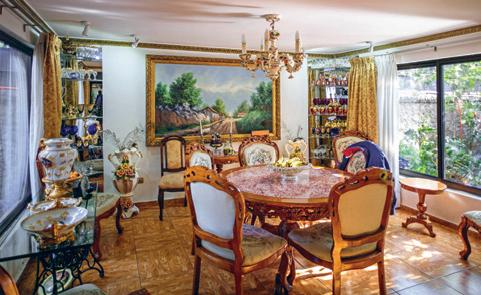
Das Privathaus in der Straße Irán 3037 wurde beschlagnahmt und diente bis zum November 1975 der DINA als Gefängnis, Folter- und Vernichtungsstätte.
Rund 100 Menschen waren hier inhaftiert, von denen 32 bis heute als vermisst gelten. Der Begriff „Venda Sexy“ bezieht sich auf die Tatsache, dass sowohl Frauen als auch Männer sexuell gefoltert, gedemütigt und missbraucht wurden.
Der Ort wurde auch „La Discothéque“ genannt, weil oft laute Musik gespielt wurde, um die Schreie der Gefangenen zu übertönen.
Nachdem die DINA das Haus aufgegeben hatte, diente es eine Zeit lang als Kindergarten
und ging dann wieder in Privatbesitz über. Am 25. August 2023, 50 Jahre nach dem Militärputsch, wurde die Enteignung des Anwesens und seine Umwandlung in eine Gedenkstätte angeordnet.
La casa particular de la calle Irán 3037 fue confiscada y sirvió a la DINA como prisión, lugar de tortura y exterminio hasta noviembre de 1975. Unas 100 personas fueron encarceladas aquí, 32 de las cuales siguen desaparecidas. El término “Venda Sexy” se refiere a que tanto las mujeres como los hombres eran torturados, humillados y abusados sexualmente. El lugar también se llamaba “La Discothéque” porque a

